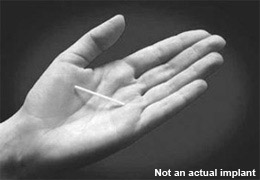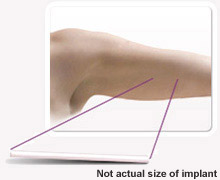Nexplanon
 NEXPLANON is a hormone-releasing birth control implant for use by women to prevent pregnancy for up to 3 years. The implant is a flexible plastic rod about the size of a matchstick that contains a progestin hormone called etonogestrel.
NEXPLANON is a hormone-releasing birth control implant for use by women to prevent pregnancy for up to 3 years. The implant is a flexible plastic rod about the size of a matchstick that contains a progestin hormone called etonogestrel.
The NEXPLANON implant must be removed after 3 years. Your health care provider can insert a new implant under your skin after taking out the old one if you choose to continue using NEXPLANON for birth control.
 NEXPLANON prevents pregnancy in several ways. The most important way is by stopping the release of an egg from your ovary. NEXPLANON also changes the mucus in your cervix and this change may keep sperm from reaching the egg. NEXPLANON also changes the lining of your uterus, making pregnancy less likely to occur.
NEXPLANON prevents pregnancy in several ways. The most important way is by stopping the release of an egg from your ovary. NEXPLANON also changes the mucus in your cervix and this change may keep sperm from reaching the egg. NEXPLANON also changes the lining of your uterus, making pregnancy less likely to occur.
When the NEXPLANON implant is placed correctly, your chance of getting pregnant is very low (less than one pregnancy per 100 women who use NEXPLANON for one year).
Protection Against STDs
The NEXPLANON device does not protect against sexually transmitted diseases (STDs). For those having sex, condoms must always be used along with the NEXPLANON device to protect against STDs. One of the concerns with the Implanon device is that women who have multiple partners and do not use condoms can be at greater risk for STDs, and there’s the possibility that these diseases could develop into a pelvic infection. This is true, though, for all methods of birth control. Abstinence (not having sex) is the only method that always prevents pregnancy and STDs.
Important Links
